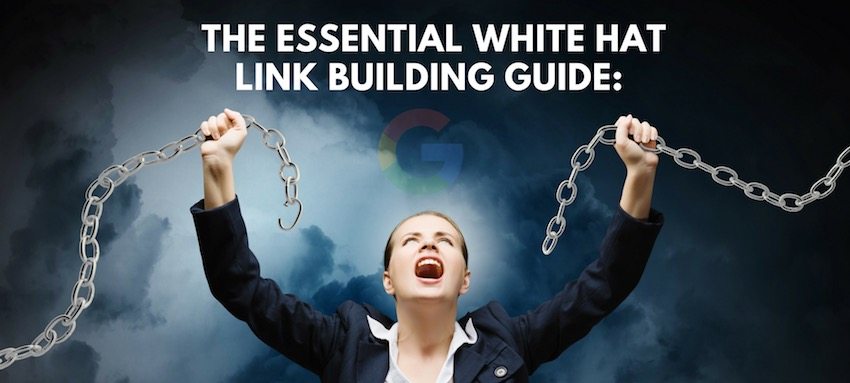White Hat Link Building Tips & Strategies From SEO Experts
What is What Hat Link Building?
Link building is the practice of highly relevant websites linking to your website. As you have more QUALITY links pointing to your site, your gain authority with Google. Without a doubt, links are still one of the TOP ranking factors in Google’s algorithm.
Building links has been an abused practice from day 1. In this expert roundup, we are going to focus on building White Hat links that will stand the test of time.
If you are looking for shortcuts, sorry.
My Top Strategies For Building White Hat Backlinks
Want the big secret? Forget taking any shortcuts. Think long term. I am not here to debate white hat vs black hat SEO. This is 2019.
#1 Create High-Quality Linkable Content
High-quality content is essential. In fact, if you talk to a link building service and they do not mention content, move on.
Putting out content for the sake of it will not get you anywhere. Although quantity can play a part in how successful you are, the quality of the material is even more critical.
What makes quality content?
Content that is free of spelling and grammar errors, unique, offer VALUE and targeted specifically to your audience.
Content is still king in 2019, so make sure your content marketing strategy is as healthy as possible. Writing blog posts is useful, but don’t forget other forms of content.
You can create resource guides, skyscraper content, infographics, and more.
A good content marketing strategy will strengthen your online presence over time, improving your authority and increasing your brand awareness.
My other White Hat SEO tips can be found at the end of this post. The last one is my secret sauce.

Marcus Miller
1. People Link to Relevant Content
While not terribly exciting, the most scalable link building strategies are always built around content. So the best tip is to identify a question or problem in your industry that does not have a great answer. Or that has answers, but that need updating or that you can substantially improve upon. If you can do this, you have what we like to call a linkable asset.
With a strategic asset in place, you can then use various strategies to promote this asset and build powerful, editorial links. Tactics here include:
- Identify links to lesser pieces of content and content the webmasters informing them of your new and improved answer that would be valuable to their audience
- Identify sites where you can submit some more helpful content and link out to your linkable asset. This will typically get you a bio link and an editorial link in the copy of the article, so it is win-win.
- Keep an eye on digital PR streams like HARO and identify opportunities to help journalists with articles. In many cases, you will be able to respond to a request for help and enrich that feedback with a link to your killer content piece.
So, when it comes to tips for link building, mine always starts with content and that makes building those links far easier.

Danny Kidd
1. In my experience, a really effective way to build high-quality, relevant white hat links is to create something new, something worth reporting as news.
The simplest way to do this is to create a survey within an industry and when you get the results, find an angle to focus on.
For example, I created a survey before about employee’s feelings about their bosses. The survey showed that female bosses were liked by 20% more people than male bosses (within the survey). The sample size was big enough to target sites with the headline.
When it comes to deciding what the content will be, think about current events. Not just in your industry but in popular culture. See if you can spin that to be about your target industry.
Google Forms is free, but it might cost you a little bit to get responses. Facebook promotion and mailing lists can help - especially if you offer a prize.
2. Many content creators focus too much on following the news and re-hashing it and not making news themselves.
Don’t focus all your efforts on guest blogging - giving your best content away is a terrible idea. Use it for your site and get people linking to you.

Anne Murlowski
When working to obtain high-quality backlinks, if you can secure links from .edu / .org or .gov web addresses, you will see a bigger bang for your buck on the time spent obtaining those links.
To lock in a .org, you may want to consider volunteering your time or joining the board of directors for your favorite non-profit organization. For .edu’s write an alumni update to your university and ask to be included in the online version of alumni news and notes.
The hardest backlinks to obtain are typically .gov as government agencies are unlikely to ‘sponsor’ a specific business. Ask your local library or workforce career center if you can provide a presentation with a blurb on their calendar or website.

Adam Mason
1. It is all about creating the right content asset
Gone are the days where guest posts built quality links. Google, fortunately, has shown there is a high enough risk to publishers to make sure they only let experts sharing good content to publish on their blog. This has pushed things back to the way they should be, and that is for businesses to think seriously about their own content and then use that for outreach.
Create an awesome piece of content that is shareable, and this makes your outreach process much easier and your acceptance rate much higher.
2. Audience research over keyword research
For years people have used keyword research to decide where to outreach. Yet they spend very little time doing audience research.
Doing audience research can lead you the right prospect websites to outreach to. Once you find out where else your target audience consumes their content you have a target outreach list that will already know their audience will love the content you are outreaching.
3. Use influencers
I work to create content with a few specific industry influencers in mind. Doing this allows you to do all the regular outreach as well as sharing that content directly to the influencers for additional exposure.
4. Create embedded interactive content
For years I have seen good content get little traction for link building just because the material was not served well.
When creating content for outreach, always keep the journalist or the audience of who will be publishing the content in mind. If you have created an interactive piece, make sure it is fully responsive, mobile friendly and fits an average article width. This allows you to outreach the content with the code already embedded and ready to be pasted into a blog.
You have already dealt with the hassle of sharing the content for the journalist, so all they need to do now is paste in the embed code, write their take on it and link to you.u.

Sam Warren
1. Leverage Partner Offers
One tactic that I have used time and time to great effect is leveraging a "Partner Offers" page. You can provide your prospective partners both a link and exposure to your customer base via the Offers page itself. It is an offer that’s hard to refuse!
All you need to do is look for partners that have similar pages on their own site. Of course, you will also want the business to be relevant to your audience (and vice versa). The ask is therefore pretty straight forwards.
"Hey there, I thought your service would be useful for our audience, and I would love to put an incentive in front of them on our Partners Page if you are up for it. I saw that you have a similar page on your site, any interest in a mutual incentive swap?"
Give the ask some personal flair, and be tactful! However, at the end of the day, it is a win-win approach for both you and the prospective partner!
James McCarthy
A great method to secure backlinks is to find websites and blogs within your company’s niche.
Then through a process of outreach and content creation, you can often land a "guest post" backlink.
I suggest utilizing an online tool (like Ahrefs), where you can explore the backlink profiles of competitors, to look to see if they have any guest post content published, and if so, on what websites.
You can also simply perform a Google search for "your subject + guest blog," and you will usually be able to find a few decent opportunities that way too.
Once you have your list of niche-specific websites/blogs compiled through competitor backlink research and Google searching, you may then begin the process of outreach, explaining your expertise and offering guest post content.
At some point during all of this, you should also be creating your niche-specific guest post content (I suggest using Ahrefs again to find valuable keywords which you can use as topics for your content). When your outreach starts to make connections, you will now have the ability to share your content, and hopefully get it published!"

Rob Watson
Link Building remains crucial to success and gives a clear signal to Google that your site is authoritative and trustworthy.
I focus on the following White Hat Link Building Techniques for myself and clients:
1. Outreach to Journalists
Journalist Outreach through services such as HARO and Source Bottle puts you in front of people with a genuine need - and some urgency - for specific information that you can help them with.
My biggest tips for success with these services are to respond as quickly as possible and answer the brief to the letter. You must make it simple for them to use your comment and if you’re not quick, they will already have enough sources to produce a good article.
2. Twitter for media contacts
Journalists also use Twitter for outreach and looking for suitable sources and will often use hashtags such as #JournoRequest . I have saved Twitter searches for certain subjects, so that if their tweet includes my keyword and the hashtag #JournoRequest, I get an instant push notification on my phone. I do this via an IFTTT recipe so that I can see the notification and respond quickly to improve my chances of getting featured.
3. Guest Posting on Blogs
Guest blogging is still beneficial too, as long as the sites you write for are relevant and have good authority. The simplest tip here is just to ask whether or not they accept guest posts and which subjects they need help with.
Also, make sure you link out in your posts to good quality external sites. This gives your post credibility, and I have even been offered guest posts by those posts I have linked out to, because they liked my post and were grateful for an unexpected link.
4. Appear on Podcasts
Podcast appearances can also be very effective as podcasts continue to grow in popularity. Usually, when you get a backlink, it comes in isolation, but by offering to appear on podcasts, you not only get a link but also the chance to showcase your expertise in great depth on the podcast itself.
Getting yourself on one podcast allows you to build something of a ‘showreel’ to showcase your expertise to other podcast hosts. You will also find that many of the other guests on a podcast have their own podcasts too, so you have a list of like-minded people you can approach, and the fact you appeared on the same podcast is a great warm intro.

Veronica Amarante
1. It’s all about community and collaboration with other brands. Create followup content from a branded event. For example, I recently attended a conference and published a takeaways blog post. The brand posted my blog post in their press section. The site has huge authority in my field and now I have a link from them.
2. Participate in publicity tactics. Like HARO, by getting published often times they will include a link to your website. Most HARO publishers have sites with authority that will link back to your account.
3. Guests posts are played out.
4. Don’t invest in black hat practices, play the long game and provide useful content. Collaborate with the community in whichever field you are in.
Dan Elson
1. Become the authority in your industry/Niche, write guest blogs, comment on your niche.
2. White HatForums/Facebook groups, reach out and add actual value, and this will result in quality backlinks, and plenty of mentions to boot!
3. Research what is in top 3 positions for your keyword and look to improve! Easier said than done, but all three of these have their own bits that Google are thinking these are the best sites so use all the bits and produce one hell of a page that features everything possible!
4. Think deeper about what else you can include on your page. Selling attraction tickets? Then talk about the local area, other attractions people might be interested. Anything that can help Google understand what your page is about - remember the most value, quality info the more likely Google will see you as the authority (linking back to point 1!)
5. Resource page. These tend to get high up in search results. You can reach out to people who have useful tools or know what they are talking about in your industry. Team up, offer a mention as you find them of value, and see where you can help them out with content or an interview or 4 tips like this!

Christopher Brown
1. Leverage your unique offerings on niche websites:
Some of our favorite link opportunities are related to the uniqueness of the client. Is there an electric car charging station in front of your building? Is your business pet-friendly? Are you located near an airport? There are several high-authority websites that specifically promote these types of businesses, and they can be highly relevant opportunities.
2. Promote your events online, no matter the size:
Many businesses hold small events, contests, or sponsorships that are used to drive foot traffic but only promoted only through social media or the business website. These small-impact events can be a big impact on link building and outreach to local influencers. Don’t just use Facebook to promote your events. From large event listing sites to local media sites, many of these outlets will not only help you get the word out but can become a high-quality link or citation.
3. Think outside the box when link building:
When we do hyper-local, targeted link outreach for hotels, we start with businesses that also serve out-of-town guests. While many of these may be obvious (e.g., event venues) some are not so obvious like funeral homes, plastic surgeons, and limo companies. Many of these websites list local accommodations and serve guests staying in the area multiple days. It’s a perfect fit, and this idea can work for other business types.

Liraz Postan
1. Earn links back
Contact sites that use your images and claim a backlink to your site.
2. Data- People LOVE Data
Use interesting data; readers would love to cite and link back: surveys, stats, case studies, fail stories... Tell the truth through numbers.
3. Competitors Lost Links
Track your top competitors for lost backlinks and try to earn them back for your site
4. Gamification and User Engagement
Create a quiz, an interactive content- that your users would want to share with friends and colleagues. Entertain your readers.
Jennifer Phillips
1. The best strategy for link building is creating unique, valuable content that people want to link to.
Whether that is research reports, infographics, or even excellent content, you’ll find you can obtain the most backlinks if you continue to refine your content creation strategy.
2. Scope out the backlinks of your competitors or businesses in the same industry.
Often this will uncover opportunities for backlinks you were not aware existed. I’ve found that this is the best and quickest way to find backlink low hanging fruit.
3. Search for broken links relevant to your audience or industry.
Start with your own backlinks and make sure you do not have sites pointing to old pages. Fixing those would be the easiest to resolve. Then, try to find broken links on other relevant sites.
Send a simple note to the site owner with the details on the broken link and suggested links (from your website of course) that could easily replace them.
4. Search online and social media for ‘ Your Keywords + Guest Post.’
This will help you identify any websites with guest posts opportunities. When I send a request for a guest post article, I typically create an abstract of a guest post that is relevant to their website so that they have details on the type of content that I would be providing.

Philippe Côté-Léger
1. Ego Branding
One thing I like to do to optimize my link building efforts is to take advantage of ego branding. Ego link building is a white hat tactic that let you find some link opportunities that you could not leverage otherwise.
It consists of creating a personal website with an ego branded domain (yourname.com or youralias.com). On this domain, you put up a simple webpage with a short bio of yourself and a section for your projects (with an in-text link with the anchor of your choice to the domains you wish to rank).
Now, since the domain will be new, the link will not have a lot of weight. So, the next step is to create a good link profile for this domain. That is where this technique gets interesting. Since we all have different passions and knowledge, we have far more opportunities to get links to our personal site than to our commercial project. If we take my example, I am an online marketing specialist, but I also have a side project called PE Help, a self-help website for men suffering from premature ejaculation.
With ego link building techniques, I can answer a HARO pitch about search engine optimization and get a link to my personal website where I talk about my online experience. But this website also links to my other projects, so I am getting indirect link benefits for Premature Ejaculation Help too. The same goes for guest postings. I can guess post on a marketing site that will boost my own domain and, at the same time, increase the value of my outbound links.
Although it is easier to leverage this technique for personal projects, agencies can also create ego branded properties for their clients. Since all companies have founder(s) and employee, you can offer them a personal website or blog as part of their SEO efforts.

Olivia Skrzypek
1. Build Your Network
Create relationships with people from the the industry, service providers, affiliates, etc. Think about friends who own related businesses that may want to link your content.
2. Create and Promote Infographics
People love infographics. Create one that may be used and shared by different businesses in your industry is a great link building idea. Here are some ideas for the infographics: process description, timeline, definitions, etc.
3. Competitors’ Broken Links
SEO consultants should always stay on top of their competitors. Their mistake is your gain. There are different tools that help you to look for broken links. Once you find one, reach out to the site administrator and replace it with a link to your site and relevant content.
4. HARO, Better Than a White Hat SEO Link Building Service
Help a Reporter Out is an excellent tool that helps to get relevant links. Look for reporters that need help within your industry and reach out to them.

Brett Downes
1. Reverse engineer HARO
We put out media requests via Haro, and when comments come flooding in, we ask for reciprocal links to help boost the long-term visibility of the site.
Usually, Haro is to quote a source and link to them. But if they have a media page or press page, we ask them nicely to link to the article from there. Packaged up like their promoting themselves, which they are, but also us.
2. Expert Roundups
Research a few expert roundups in our niche over last six months. I log all People, website details that have contributed to the roundup. Then use majestic/ahrefs to see how many of them voluntarily linked to it.
This gives us a bona fide list of prospects that usually link to the roundups they’re included in. Instead of just hoping people link to the piece, we have warm leads.
3. Skyscraper
Instead of taking someone else content and bettering it and letting everyone know who shared it before or commented on it. We will offer a completely alternative view even controversial, disputing the opinion.
There are anomalies and exceptions in all cases, use this to push your point. It starts a debate and is a good way to earn links.

Tracy Julien
1. Scan Broken Backlink Profile to Change Old Products to Category Pages
Although a "been there, done that" link building tactic, broken link building is still just as relevant in 2019 as it was any year prior. Instead of just using a tool like Ahrefs and clicking on the "broken backlinks" tab, dig deeper and search around old subdomains or for products that are out of stock. This can be a quick and easy win in order to get links to category or product pages.
Changing these old links to product or category pages will ensure that no link juice is wasted, and can increase overall rankings for those e-commerce pages, therefore, producing high quality links.

Kent Lewis
1. Competitive benchmarking
The best place to look for inbound links is competitive websites. By conducting an inbound link analysis, you can identify which sites are desirable (high domain authority) and likely to provide a link to your business.
2. Compelling Content
This seems obvious, but far too many businesses fail to create unique content that is shareable. This could include timely blog posts, well-researched articles, infographics, and videos. Based on the competitive benchmark mentioned earlier, you should have a good idea of what type of content is being developed and how to do it better or differently.
3. Get Coverage
Leverage resources like Help a Reporter Out (HARO) to pitch yourself as an expert and secure quotes with links back to your website from credible third-party press/media sites.
4. Partner Smartly
Leverage key relationships with strategic partners, customers, vendors and other industry sites to secure links, ideally without reciprocating.
Garrett Smith
1. Educational Resource
Create an educational guide that fills a knowledge gap in your niche. Guides like these are easy to share with bloggers, journalists, and other media entities who are always looking for reputable reference content.
2. Conduct a small research study.
Research studies are getting easier and easier to execute on, and the unique data you generate, is very easy to pitch. Writers are always looking for facts from studies to include in their content, to back-up their statements.

Brandon Chopp
1. Influencer Marketing
We use influencer marketing as part of our digital marketing strategy for our ecommerce brand. Our target audience includes fashion oriented people who attend music festivals and enjoy electronic dance music. We engage in influencer marketing in a variety of ways.
2. Start at Instagram
Instagram is huge for us - we find popular accounts who meet our criteria for selection, and we engage in a conversation to gauge whether or not it’s a good fit. We also use a platform called Tomoson, which is tool that helps pair influencers with brands. Often times, we will send one of our products to an influencer for free, in exchange for an honest review that is posted to their blog or social media followers. For us, the most important element of an influencer package aside from cultural fit, is the overall reach of their blog or social media accounts. We measure our return on investment based on the number of impressions we receive, how much referral traffic we get, and of course - how many sales come as a result of the campaign.

Mark Aselstine
1. HARO
If you‘re not using HARO, you’re missing out on some seriously great (and easy links). Having handled some of this on both sides, as both a source and a writer, make sure you include your response in the initial email response. Writers don‘t want to have multiple back and forth’s, they just want this to get done.
2. Be Flexible Within Your Niche
One thing I‘ve found while reading SEO blogs, there’s always a huge number of suggestions about how to build links. Certainly we should know how to do the skyscraper technique, be good enough at writing for guest blogging and be creating great content on our own sites. But, within our niche, we should be flexible. Instead of finding blogs that fit into whatever link building model you’re attempting currently, keep an open mind and be flexible. Almost every blog in your niche can fit into one of these, so trying to figure out which one, instead of fitting them in, makes life a lot easier.

Kitty Lusby
1. We found a way to give back to the digital community and build relevant, quality backlinks at the same time using our Unsplash page.
Our staff photographers are always taking photos to use on marketing and business articles, and we upload our best work to Unsplash so that the internet community can download and use these pictures for free. This was purely good karma until Unsplash started encouraging downloaders to include photo credits. Now, we use Buzzsumo to track mentions of our brand name, and we see about 150 to 300 mentions per month thanks to photo credits.
Whenever the mention is on a relevant website, we reach out to the author or editor and ask them to update the photo credit with a link pointing to our website. Since these people have already received value from a free image, and the act of including photo credit itself indicates they’re willing to include outbound links, we have a very high response rate. The backlinks we generate often come from very high authority domains and very visible brands, many of which we could access no other way.

Lewis Ogden
1. Provide more VALUE in your content. I have made a lot of money over the years targeting the low hanging fruit and long tail keywords. However, the trend is now to build monster guides of 5-10k words or more.
The trouble is, most of these "buyers guides" are garbage and provide no value whatsoever. If you want to up your game in 2018, focus on the visitor intent.
Ask yourself questions such as:
- What do they want to know?
- What is their end goal?
- Where are they in the buying process?
Most importantly, ask "How can I provide the very best piece of content for my audience on this topic."
By doing this you will not only have much a higher conversion rate, but you will also rank for a ton of long tail keywords that will bring in a boat-load of traffic.
2. Build branded backlinks. SEO’s are forever getting caught up in "keywords" and using exact or partial match anchor text when building links.
It is time to move on; this is no longer 2009, Google is smarter. They already know what your page is about, this is what your On-Page SEO is for. They do not need you to hold their hand by building links with anchor text like "best electric shaver."
So stick to an anchor text profile like the big brands have, which is mostly generic anchors, such as ‘click here’ or ‘view more,’ but primarily branded and URL anchor text.
3. Finally, this last tip is responsible for boosting my income over 2017, and I will be doing even more of it in 2018.
Essentially what you should be doing is building backlinks to your very best informational pages. Your "How To" guides and anything that solves the visitor’s problem.
From these pages, you will create internal links to your money pages. They key here is that you can control all of the internal anchor text to your money pages and you can be a little more ‘aggressive’ with them too.
This tip alone will not only boost your money pages up until the SERP’s but will also drive more traffic to your informational pages since they are getting some excellent juicy links via outreach.
Craig Emerson
I use multiple white hat strategies for link building, some of the more unique and successful linking building campaigns I’ve used are as follows:
1. Image Sharing
This is the gift that keeps on giving and is something that can be implemented in short order. It is as simple as taking any picture related to your niche and sharing it on an image sharing site like Flickr.
Add some attribution text that includes a link back to your site, and if anyone includes this image on their blog, you’ll get a free backlink. The best thing about this tactic is you can keep receiving links for as long as that image is available. The more image sharing sites you post your picture to, the greater the chance of your image being found.
Tip: The image you share, doesn’t necessarily need to be related to your niche. A link is a link, so share as many quality images as you can to increase your chances of receiving a backlink.
2. Broken Link Building
Now there’s a number of tactics you can use to find broken links, and some of them are overly complicated that require subscriptions to SEO tools. There’s a much easier way, and it won’t cost you a thing other than your own time.
Simply download the “Check My Links” Chrome extension, and you will be able to easily identify broken links on any page. To target blogs in your niche, so you can focus on links that will build your trust score, do a Google search on your niche and terms that will identify link pages on other blogs (e.g.,/ links, resources, resource page, etc…).
Once you have a page to target, a quick check using the “Check My Links” Chrome extension will identify any broken links on that page.
Reach out to the blogger with a personalized email to let them know about the broken link and offer up your link as a potential replacement. You have a much higher chance of securing a link, because you are letting a fellow blogger know about a problem on their site. I’ve had conversion rates as high as 10% with this tactic in the past.
3. HARO: Help A Reporter Out
This is a great opportunity to secure links from news sites, publications, and other blogs, and I have had conversion rates as high as 20% with this approach.
HARO is a free subscription service, and once registered you’ll receive three emails every day from reporters looking to quote experts on a variety of different topics.
To increase your chances of success in getting quoted, you need your pitch to stand out from all the other responses a reporter may receive. Reporters are busy professionals, and they don’t have the time to chase down a number of responses to their query, so you’re looking to save them time. Be sure your pitch gives them plenty of information, so they don’t have to waste their time following up on a request.
I have had great success with each of these techniques, and the best part about each of them is they don’t require much time to implement.

Laura Simis
Here are some of my most important tips, especially in 2019 as Google continues to improve the way they value high-quality links:
1. Wrap what you know into a more significant topic:
Many of the clients I work with are working in industries that aren’t particularly interesting to your average person - but pest control fits into a lot of other more engaging, newsworthy topics. Our link building approach involves incorporating what we know under a bigger umbrella - what does a pest control expert have to say about Zika Virus, or about keeping your dog safe from Lyme disease, or about keeping rodents out of your storage unit?
Form connections and maintain your network: Don‘t be afraid to ally yourself with people in adjacent industries. If you work with a reporter once, don’t be afraid to let them know that you can be a resource for them again in the future.
2. Communicate value in your outreach:
I spend a lot of my time doing outreach to other sites, but I‘ve also been on the receiving end of link building outreach. Don’t waste your time emailing people if you’re not going to tell them what they have to gain from sharing your content. Do your research on what kind of information they publish, who their audience is, and why your content would benefit them.
3. Follow up!:
Two of the most important characteristics a link builder can have are charm and persistence. Don‘t be afraid to reach out more than once. Track your outreach attempts (who you’re talking to, when you did your original outreach, and when you plan to follow up.)
If you can break it down, even more, take notes on what time of day or day of the week is best to reach certain people. Take notes on what kind of content they share. Keep in mind; a no doesn’t always mean no - sometimes it means "not right now."

Izaak Crook
1. My top white-hat link building tip is to reach out to people who’ve linked to similar content as yours.
It is super easy to find similar content using a tool like BuzzSumo or Ahrefs Content Explorer. You can even sort by the most linked-to content to see what is worth your time to pursue.
I like to find articles similar to our own and then created a mail-merge to send everyone who linked to the content an email letting them know about ours. This works exceptionally well if your article is better than the one they linked to.
Ahrefs is probably the best tool for this; it is a pretty complete suite that lets you find the content, who linked to it, and export that content. Plus the data you export is full of useful metrics like the ‘Domain Rank’ and number of people linking to each page.
I use a tool called Hunter.io to find the emails for people who linked to each piece of content, and then ‘Yet Another Mail Merge’ to send a personalized message to each of them. Something like ‘hey, you linked to X - so we thought you would like Y!’.
This works like a charm if you want to build quick links to a new piece of content.

Nick Leffler
There are a lot of different link building methods that can be used to effectively grow a website. These tips focus on white hat SEO for local businesses.
1. Sponsor a local event.
You’ll often get linked to from the event website and even from local news.
2. Join your local chamber of commerce.
Every business that’s a member has a link to your website and that local link holds a lot of local SEO power.
3. Donate to a local charity.
You can look for local charities that link to those who have donated. You can get a high-value link, get a tax write-off, and do something good too.
None of these are considered black hat at all, and in fact, Google partakes in some of these link building methods also.
Michael Mason
1. Write a testimonial about services you are currently using.
Not everyone will post your testimonial, but any company in the world would be happy to get a positive testimonial from a satisfied customer. And don‘t ask first, go ahead and write the testimonial and send it over. At best you’ll get a great link and, at worst, you’ll make them pretty happy.
2. Create an infographic.
If you’re handy with graphics, infographics can be irresistible to brands, especially in this content heavy era we live in. Create a useful, simple infographic that people would be tempted to share. Not all may link your website, but quantity is your friend here.
3. Write a definitive‘ list on your blog, but for something that’s underserved.
Think about the lists that are abundant in your particular field and then think a level or two more. Create a list about that. People love the simplicity and usefulness of lists, and you’re sure to get some sharing traction with a really effective one.

Alex Nebilyca
1. Find articles, where a representative of your competitor is giving his/her opinion on a topic (related to your industry). See if you can argue about his/her opinion on the matter.
Write a much better and detailed opinion of yours and send it to the author of the topic with a similar pitch:
"Hello. I found your article really interesting for people from my industry. However, I found this answer a little bit incomplete and want to give you my opinion which is more detailed and up-to-date. I think your readers will be glad to read it.". And provide a link to your corporate website.
2. Find articles related to the topic of the website you are promoting and start a discussion in the comments section with the author. You should display that you are a professional in this field too and have something valuable to say.
After a relationship is established, propose to write a new article on a related topic.

Krishna Rg
1. Create various types of content
Infographics, videos, and listicles are few types of contents that can be great to link.
2. Guest posts are great
Landing a guest post on authority sites can improve your audience size as well as help in branding.
3. Broken links are magic
Find broken links in blog posts that are highly related to your target keyword. Now email the admin to get your backlink. ( 404 pages work too )
4. Don’t be pushy
Approach the person for a long-term relationship. Add value to their audience. Don’t force them to link you and run away.
Ashish Goswami
You must have heard that link building is dead. I would say yes it’s dead. Well only for those who failed to adapt.
Google has confirmed that links are the #1 ranking factor, alongside great content.
1. Skyscraper Technique
The skyscraper technique is a data-driven technique of coming up with a proven content Idea.
And when I say proven, it means the similar content idea already has tons of social media shares & backlinks.
You won’t find such opportunities quickly. You might have to spend time and review lot of articles. But, once you discover one opportunity, it will bring you a ton of shares & backlinks.
Results:
Using this exact technique - we get close 20 links per content piece we publish. All these links are high quality and quite valuable.
This does take a lot of your time, but is free and is repeatable to increase your organic traffic consistently.
2. Use Testimonials
This is a win-win scenario. Many businesses offer you a chance to say a few words about your experience with their service or products. This is the perfect way for them to build customer trust. It is also an excellent opportunity for you to get a backlink and potential traffic from that site.
This tactic usually has a much higher approval rate than your standard link request emails.
3. Broken Link Building
Simply find a page with a broken link on it.
- Discover what used to be on the dead page.
- Check if you have similar content or create a new high-quality, relevant content.
- Reach out to the webmaster/editor to report a broken link and suggest your content as a fix.
Nobody wants dead links on their site. You can reach out with quality relevant content to as many prospects as you can find.
Alex Deckard
1. One of the most effective link building techniques I have come across is always to leverage real life. For example, if your company is hosting an event, find a caterer that is willing and able to share and link to your event page or website.

Trenton Miller
1. HARO for PR
Issuing press releases on a wire can be a waste of time for link-building. You will likely only get no-Follow links.
Instead, Help A Reporter Out. Sign up for HARO. It is free. Use an easy to follow email template to speed up the delivery of responses. Write good stuff, and you will be rewarded with those hard to get do-follow links.
2. Broken Link Building
Use a platform like BuzzSumo to hunt down broken links on high authority websites. If you have a piece of content that can replace that broken link, email someone at that website the link to your content and make sure to ask them for a doFollow link as a reward for your hard work.
3. Local Outreach + Video
Reach out to small business owners in your area and interview them. These can be written, but a video would be even better. You will end up with content for your website and social media, and in return ask them for links and shoutouts to the content once it is posted from there own sites and social accounts.”

Joe Balestrino
1. Create content that is worthy of linking.
Use buzzumo.com to find the top content in your industry and see how their content is constructed, the length and take note of who is linking to it. Create a similar piece of material as go to those sites that link to your competitor’s website and ask if they would like to yours.
Don’t create the same exact topic. Take note of what made the content worthy of linking to and duplicate it the best you can.
2. My favorite whitehat natural link building tactics is videos or podcasts.
I tend to create a video or podcast to go along with a good how-to or informative article. I will then place that video on youtube, Vimeo, and other channels to gain links and subscribers. These subscribers are more likely to share my content and help my content rank better as well as help me to grow my following.
Having a podcast has the same impact. As long as you have content to support the audio or video file you increase your chances of gaining links, relevant traffic and followers/listeners.

Adam Thompson
1. Use Google Consumer Surveys to collect newsworthy original research.
For as little as $0.10 per response, you can run targeted consumer research to create content for your website that journalists and other sites will cite (link to) as an original source.
2. Host a newsworthy local or regional event to get links from local newspapers, bloggers, etc.
For example, host a free one-day conference for your industry, and post all the event details and registration form on your website. Identify key area newspapers, industry bloggers that live in the area, etc. to reach out to.
Make sure all the event details are on your website, so bloggers will naturally link to your site for more information. If the event is held at your physical location, that will also encourage bloggers to link to your website.

Akshay Hallur
1. Guest posting:
No matter what Google says, this thing still works. Many newbies find it hard to find the blogs to guest post on. Here are the ways by which you can find blogs to guest post on.
Use search modifiers or footprints like NICHE "write for us," NICHE "contribute," NICHE "guest blogger," and so on.
While doing this keep Ahrefs Bar or MozBar active to find only authority sites for guest posting.
Use reverse guest author bio search.
This is a crazy strategy I found myself. Suppose John Doe is your competitor and carrying out great guest blogging campaigns, you can search his author bio in Google like "John Doe is a blogger at JohnDoe.com." By this, you stumble across all the sites John Doe has guest blogged on.
Use Ahrefs or SEMrush. Dig into your competitor’s backlink profiles. Apply filters like WordPress backlinks, Dofollow, and so on. Arrange the backlinks by descending order of the domain’s authority.
Implement copywriting while outreaching guest posting prospects. Treat outreach emails as your sales copies and follow-up. Don’t underestimate copywriting.
2. Create graphics-heavy content
I’m implementing this strategy on my blog. I dive into my Analytics and list out popular posts. Then I add at least three info-heavy graphics and possibly an infographic. This attracts good backlinks in the long run if your post is about a unique topic and getting good traffic.
You can also consider hiring a graphic designer, to create vibrant graphics and upload to Flickr, and other sites with a copyright-free attribution license.
3. Skyscraper technique
This strategy by Brian Dean is the ultimate strategy if properly implemented. Create unbeatable best content. Your content should be insightful than all the other content on the web on the same topic.
Outreach to the right guys to get your content shared and linked. The art of outreach matters. Gather as much data as possible regarding the people who you are outreaching to. Now send super-personalized emails.
Emily Jones
1. Chasing broken links.
If you have an old, related domain, check the backlink profile for that URL and then email those webmasters with your current URL asking them to "cite you correctly." Webmasters will be happy not to have a broken link, and you will reclaim the work you did to get that link in the first place. I have gotten back some really valuable links with longevity this way.
2. Help A Reporter Out
The best white hat links I have gotten have come from HARO.

Samuel Scott
1. Stop hiring link builders and actively trying to build links
The best and most significant numbers of authoritative links on relevant websites are just natural by-products of good media relations and publicity activities.
2. Do Better PR
The links will come naturally when people mention you or your company. As Matt Cutts once said, the goal is not that your links should appear natural but that they be natural.

Gavin Duff
1. Stop thinking about aggressively building links and instead leverage relationships that you already have, testimonials that you may be able to give, your great content that people may want to talk about or share - and very importantly, that they may want to link to.
2. Don’t forget that your website has likely been around for a while, and sites change - a lot. Run an annual audit.
3. Use a tool such as Link Research Tools to find historical links that you had from strong, reputable and trusted websites that are now going to broken pages on your site. Then reach out and ask them to instead point to the correct page, or redirect your old broken page to a new one. This will help both your SEO and your referral traffic.
4. When writing content, don’t focus on just one or two core keywords. Think about the topic you are writing about and consider other related topics.
Create a taxonomy of search words, queries or questions that users tend to have around what you are talking about - and be a resource for them. Keyword repetition does not work anymore; it is all about providing value and Google like to know that your content is in-depth and will satisfy a user’s query.
5. It may be time to audit your old content. Using historical Google Analytics data, look at what articles, blog posts or other pieces of content were most engaging or perhaps received the most referral traffic.
There’s a good chance that these were the ones that were most interesting to people and may give you some ideas on the direction of your future content strategies.

Jack Saville
1. Use Slack communities for link outreach.
Try and find slack groups related to your product or field, and promote your content within them. Then if communities find your content interesting, they may link to it.
However, do not plug your content too often, as that will likely see you kicked out of the Slack group.
If you cannot find any Slack groups related to your industry, then make the one!
2. Double down on data.
Making sure you are concentrating your SEO efforts where it counts is an important way to keep your SEO strategy sustainable.
By becoming best friends with your PPC specialist, you can find out which keywords are getting the most conversions, and which keywords have the highest monthly search volume. Using this data, you can find out which keywords are most important to you, and focus on trying to rank for the keywords that will make a difference.
3. Is your site rich results ready?
Rich results will become increasingly more common in the search results in 2019, and your site needs to be ready to take advantage. Make sure your onsite structured data is as complete as possible.

Steffen Ploeger
1. Content will continue to be king
Search engines will show the end user what it believes to be the most appropriate website for any given search. Furthermore, time on site/page, as well as click-through rate, plays a prominent role.
An example is the end user searching for hardwood flooring. Several websites pop up.
Website 1 - Contains several pages focusing on hardwood flooring, how to install, how to choose, how to lay, how to clean, how to measure, how to install on concrete, and so on.....
Website 2 - Contains one page focusing on hardwood flooring - which products they offer and their suppliers
Website 3 - Contains one page focusing on hardwood flooring and one article on how to install hardwood flooring.
Which website is obviously outranking all of them? Website 1, if they provide proper titles and meta descriptions as well as effective keyword use. (keyword research is a must)
Elements such as title, meta description, meta keywords, heading, h1, h2, text, alt text, title tags and internal links. Structure!
2. Quality inbound links still matter.
Make sure these links make sense. A page/article talking about clothing should not link to an article/page about hardwood flooring.

Bernie Clark
1. One white hat SEO tip I always emphasize is: maximize the number of backlinks you can get as a result of regular, everyday business activity. For example, make sure that you optimize profiles for all of the organizations you and your employees are a part of, write testimonials for vendors, acquire backlinks related to philanthropic and charitable activities, etc.
2. Reaching out to media outlets that have mentioned your company or brand, and request a link to your website. Some journalists will add attribution links, but others will simply credit you as a source in plain text. The practice of reaching out to reporters or press site webmasters can be time-consuming, because you have to find unlinked clips, but can pay off since links from news outlets carry a lot of weight regarding your backlink profile.

Justin Herring
1. Find rising influencers.
Once you start seeing the same author on several websites writing guest posts in the niche you are targeting then search Google for the author’s name. It should pull up all the sites they have written for. Now contact those websites as you know they offer guest posting.
2. Don’t rely only on tool metrics like DR and DA to get backlinks.
Look at the referring domains and the site traffic. If you have a lot of quality referring domains and the site is getting actual traffic, then it is an excellent website to get a backlink from.
3. Need immediate traffic to your blog article and social proof?
Submit it to "Quuu Promote" in the corresponding category and you should start getting new targeted traffic within days. It’s not free but cheap for the amount of traffic it can send your website.
Roman Daneghyan
1. HARO
If you‘re not using HARO, you’re missing out on some seriously great (and easy links). Having handled some of this on both sides, as both a source and a writer, make sure you include your response to the initial email response. Writers don‘t want to have multiple back and forth’s; they just want this to get done.
2. Be Flexible Within Your Niche
One thing I‘ve found while reading SEO blogs, there’s always a huge number of suggestions about how to build links.
Certainly, we should know how to do the skyscraper technique, be good enough at writing for guest blogging and be creating great content on our own sites. But, within our niche, we should be flexible. Instead of finding blogs that fit into whatever link building model you’re attempting currently, keep an open mind and be flexible.
Almost every blog in your niche can fit into one of these, so trying to figure out which one, instead of fitting them in, makes life a lot easier.
#2 Have a Content Promotion Strategy and Be Consistent
Content is pointless if nobody sees it.
Google claims that consistency of publishing new content is not a factor, I disagree. First, consistency can develop a regular audience. As you release more content, your website grows with up to date, current information.
It is not enough to just create great content; you need to promote it.
After you publish content, your job has just started! Create a content promotion checklist and use it.
#3 Follow Trending News and Topics
What is a link?
It is basically a share.
There are many tools you can use to track trending topics, Google Trends, Buzz Sumo, or your social media timeline.
A recent example of a prominent trend that I hopped on “early” was Cryptocurrency. I had to get creative, how do I tie Crypto into online marketing to fit into my blog?
Long story short, I published a timely post just st the craze started to hit the news and social media. I created a poor man’s infographic and covered various aspects of the money word, cryptocurrency marketing.
The story took off on social media, drove significant traffic, and generated a few backlinks. Link results were not spectacular, but the post has driven 10+ leads. Are we making money or building links? I have never taken a link to the bank.
One lead resulted in a substantial client for my newly launched SEO consulting service.
I passed on several of the other opportunities for various reasons.
Are these rankings going to make me millions, probably not?
But who knows with a new potential booming vertical.

#4 Cultivate Media and Influencer Relationships As A Link Building Strategy
Forget this advice for small clients or if you are trying to build links to your blog; this is the big leagues.
How do I build white hat links for most of my clients?
How did I rank #1 for SEO Expert with a new domain in 9 months? Download my Ebook.




